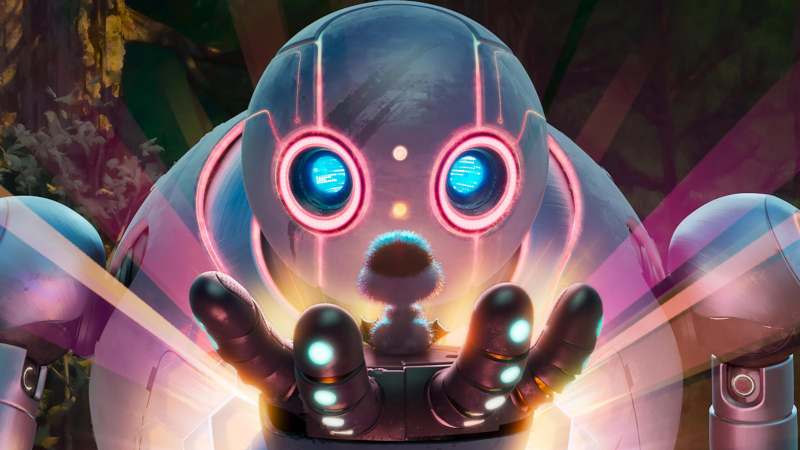Director – Chris Sanders – 2024 – US – Cert. U – 102m
****1/2
A service robot shipwrecked on a desert island is imprinted as its mother on the mind of an orphaned gosling – out in UK and Ireland cinemas on Friday, October 18th following its screening in the London Film Festival
Waking up on an unknown beach with no idea as to how she got there, ROZZUM Unit 7134 (voice: Lupita Nyong’o) is a Universal Dynamics service robot designed to complete any task assigned to her. Without any such task, she feels completely lost. She wanders around the island, populated only by animals, in search of her owner. Unable to understand all the noises the animals make communicating with each other, she has her translation circuits decode their meaning so that, soon, she is hearing them communicate in English.
She accidentally almost destroys a family of geese but managing to rescue a goose egg. She must protect the egg from the fox (voice: Pedro Pascal) who attempts to steal it to satisfy his hunger. Her robotic rationale for this is to question whether the egg is the fox’s property, A thought process that might make sense in a human environment but makes none at all in this animal one. In due course, the egg hatches, causing the gosling (voice as a baby: Boone Storm; voice later: Kit Connor) to imprint the robot – the first being it sees – as its mother.

Suddenly, 7134 has a purpose: to be the gosling’s mother and to raise him. The fox – who has now called a truce, and promised not to eat the gosling – breaks it down into three tasks, which she converts into a simple, visual infographic. She must teach the gosling to eat, to swim and to fly. The Fox, whose name is Fink, has christened the robot Roz and she, in turn, after a few false starts, has come up with the name Brightbeak for the gosling.
This three-point programme ought to provide the rest of the plot, but it zips through ‘eat’ before you can blink, spends a reasonable amount of time on swim and then, when it comes to flight, loses its way by reverting to a subplot about sending a homing beacon to its parent company, who send out militaristic bots to come and bring it back. The last half hour or so is consequently somewhat confused, with the film’s loyalties divided between the different plot directions on offer.
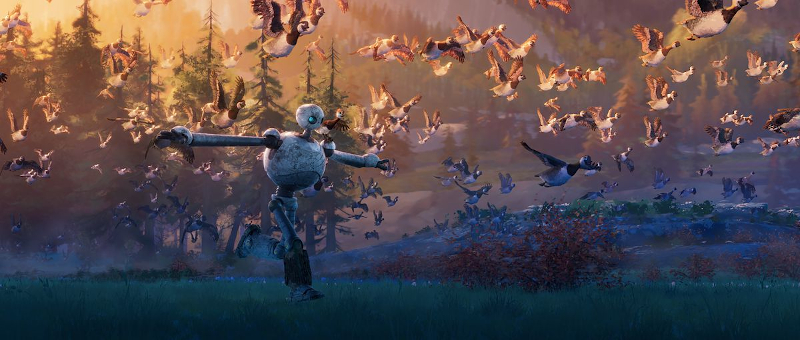
Before that, its time spent on ‘swim’ involves the gosling – who, it turns out, is small in size and would have been the runt of the litter – being bullied by his bigger contemporaries when he tries to join the herd. He also has picked up Roz’s way of reasoning and speaking – and given that the robot is regarded among the animals as a dangerous monster, finds himself ostracised and facing no small degree of prejudice.
Adapted by director Chris Sanders (writer of How to Train Your Dragon, 2010; Lilo and Stitch, 2022) from the remarkable first book by author and illustrator Chris Brown, the film has some striking elements going for it. For one thing, it features an outstanding voice performance from Nyong’o which is so good it would probably carry the film if the animation was substandard, or if the soundtrack was reworked as a radio drama. The voice cast also includes Bill Nighy as the goose leader, Catherine O’Hara as a possum mother hilariously attempting to teach her kids how to play dead, and Mark Hamill as a bear.
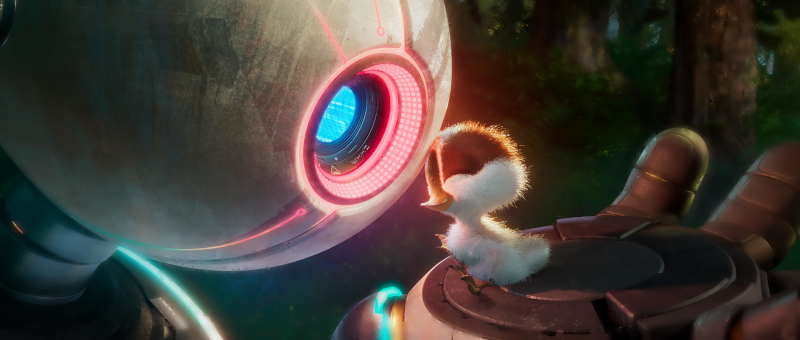
Then you have the character design of the robot. My first thought was that it reminded me of all the robots wandering around the decaying civilization at the end of Laputa, The Castle in the Sky, Hayao Miyazaki, 1986) with birds nesting on them, an image which feels very close to the spirit of Roz who ultimately comes to care for nature. My second was The Iron Giant (Brad Bird, 1999), another animated film about a child being befriended by a robot, of which I’m sure Brown was aware (he certainly has a picture of Ted Hughes’ The Iron Giant as one of the books in the pile that influenced him).
If you can get past those similarities, though, Roz has lots of parts which detach or get pulled off – hands that fly off to find and retrieve items, for example – and has been programmed for mimicry: one of the first things she does, at the start to get off the beach to escape the incoming tide is to copy a crab’s climbing a cliff face by scuttling up it sideways.
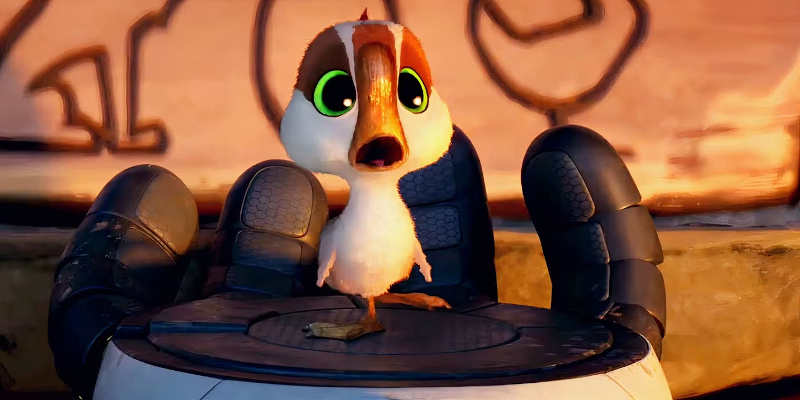
More significantly, perhaps, this robot is female, where most robots in science-fiction are male. (Admittedly there is the robot Maria in Metropolis, Fritz Lang, 1927, but she is a doppelgänger of a real person which is nothing like what we have here.) And that’s because this robot is a caring, indeed nurturing, type – which is a talent generally executed rather better by women than it is by men. And finally, this is a film about a mother, unprepared to raise a child, working it out as she goes along, which is a pretty universal idea.
There is a second female robot seen briefly at the end, Vontra (Virtual Observational Neutralizing Troublesome Retrieval Authority) (voice: Stephanie Hsu) who is in charge of the male robots tasked with retrieving Rozzum 7134, who is more malevolent and consequently more in the robot Maria vein.
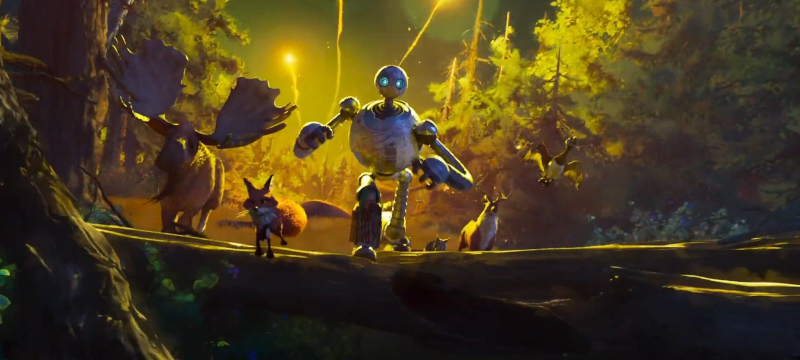
Yet, with its cast of a robot and talking animals, the piece resembles not so much science fiction as Disney’s Bambi (David D. Hand, 1942), if it were remade from the mother’s point of view.
Visually, the film makes a giant stride in the medium of animation for which it’s hard to believe it won’t pick up some sort of technical Oscar, perhaps one with a specially designated title. There has long been a problem with 2D animation, which occurs when backgrounds are beautifully rendered and characters painted on cel (as 2D animation used to be done) are flat areas of colour. These days, the standard (rightly or wrongly) is to make animation with computers in a modelled 3D environment.
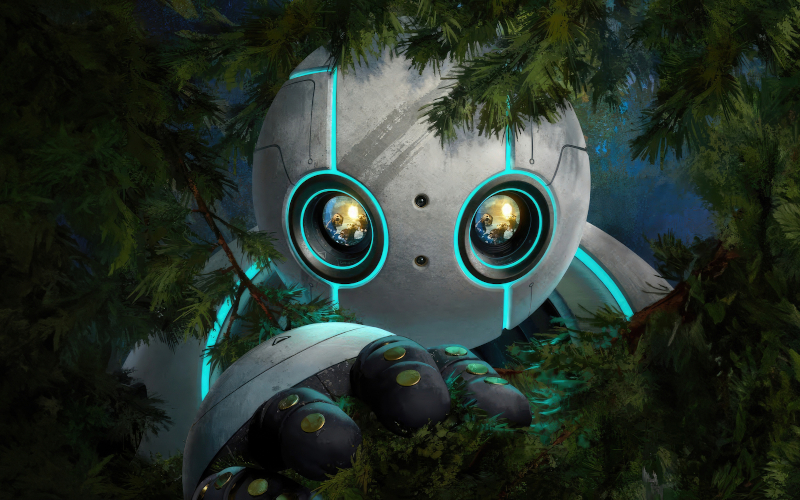
What has been done on The Wild Robot, is to treat both 3D environment and 3D character modelling as surfaces to be painted, which means that, if you pay attention in visual terms, you’re watching something like an oil painting coming to life in three dimensions, which is a remarkable feat. (That’s a slightly different concept from films like Loving Vincent or The Peasants (DK Welchman, Hugo Welchman, 2017 and 2023) which actually animate oil paintings.)
Yet, in the end, impressive though they are, it won’t be the technological advancements that win you over, but the fact that the film presents such a striking portrayal of female nurturing and motherhood.
The Wild Robot is out in cinemas in the UK and Ireland on Friday, October 18th following its screening in the London Film Festival.
Trailer:
